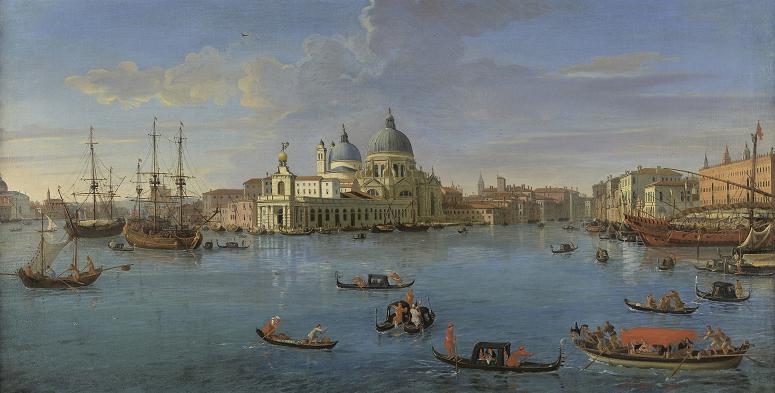Santa Maria della Salute (c1680). Santa Maria della Salute, commonly known simply as the Salute, is a Roman Catholic church and minor basilica located at Punta della Dogana in the Dorsoduro sestiere of the city of Venice, Italy. It stands on the narrow finger of Punta della Dogana, between the Grand Canal and the Giudecca Canal, at the Bacino di San Marco, making the church visible when entering the Piazza San Marco from the water. The Salute is part of the parish of the Gesuati and is the most recent of the so-called plague churches. In 1630, Venice experienced an unusually devastating outbreak of the plague. As a votive offering for the city's deliverance from the pestilence, the Republic of Venice vowed to build and dedicate a church to Our Lady of Health. The church was designed in the then fashionable baroque style by Baldassare Longhena, who studied under the architect Vincenzo Scamozzi. Construction began in 1631. Most of the objects of art housed in the church bear references to the Black Death. The dome of the Salute was an important addition to the Venice skyline and soon became emblematic of the city, inspiring artists like Canaletto, J. M. W. Turner, John Singer Sargent, and the Venetian artist Francesco Guardi. Beginning in the summer of 1630, a wave of the plague assaulted Venice, and until 1631 killed nearly a third of the population. In the city, 46,000 people died whilst in the lagoons the number was far higher, some 94,000. Repeated displays of the sacrament, as well as prayers and processions to churches dedicated to San Rocco and San Lorenzo Giustiniani had failed to stem the epidemic. Echoing the architectural response to a prior assault of the plague, when Palladio was asked to design the Redentore church, the Venetian Senate on October 22, 1630, decreed that a new church would be built. It was not to be dedicated to a mere plague or patron saint, but to the Virgin Mary, who for many reasons was thought to be a protector of the Republic. It was also decided that the Senate would visit the church each year. On November 21 the Feast of the Presentation of the Virgin, known as the Festa della Madonna della Salute, the city's officials parade from San Marco to the Salute for a service in gratitude for deliverance from the plague is celebrated. This involved crossing the Grand Canal on a specially constructed pontoon bridge and is still a major event in Venice. The desire to create a suitable monument at a place that allows for easy processional access from Piazza San Marco led senators to select the present site from among eight potential locations. The location was chosen partially due to its relationship to San Giorgio, San Marco, and Il Redentore, with which it forms an arc. The Salute, emblematic of the city's piety, stands adjacent to the rusticated single story customs house or Dogana da Mar, the emblem of its maritime commerce, and near the civic center of the city. A dispute with the patriarch, owner of the church and seminary at the site, was resolved, and razing of some of the buildings began by 1631. Likely, the diplomat Paolo Sarpi and Doge Nicolo Contarini shared the intent to link the church to an order less closely associated with the patriarchate, and ultimately the Somascan Fathers, an order founded near Bergamo by a Venetian nobleman Jerome Emiliani, were invited to administer the church. A competition was held to design the building. Of the eleven submissions, only two were chosen for the final round. The architect Baldassare Longhena was selected to design the new church. It was finally completed in 1681 the year before Longhena's death. The other design to make it to the final round was by Antonio Smeraldi and Zambattista Rubertini. Of the proposals still extant, Belli's and Smeraldi's original plans were conventional counter-reformation linear churches, resembling Palladio's Redentore and San Giorgio Maggiore, while Varotari's was a sketchy geometrical abstraction. Longhena's proposal was a concrete architectural plan, detailing the structure and costs. He wrote: I have created a church in the form of a rotunda, a work of new invention, not built in Venice, a work very worthy and desired by many. This church, having the mystery of its dedication, being dedicated to the Blessed Virgin, made me think, with what little talent God has bestowed upon me of building the church in the. shape of a crown.
more...













